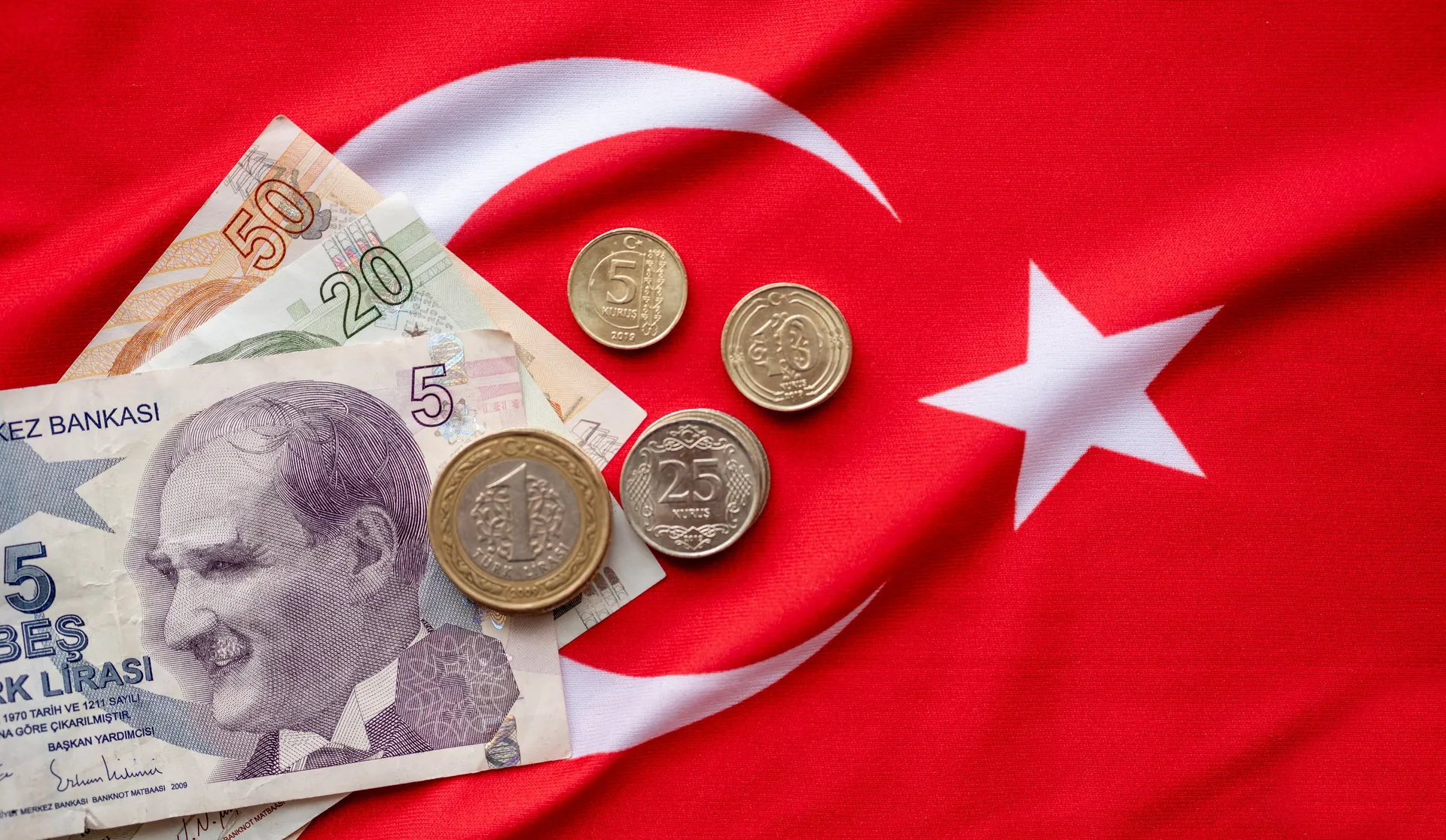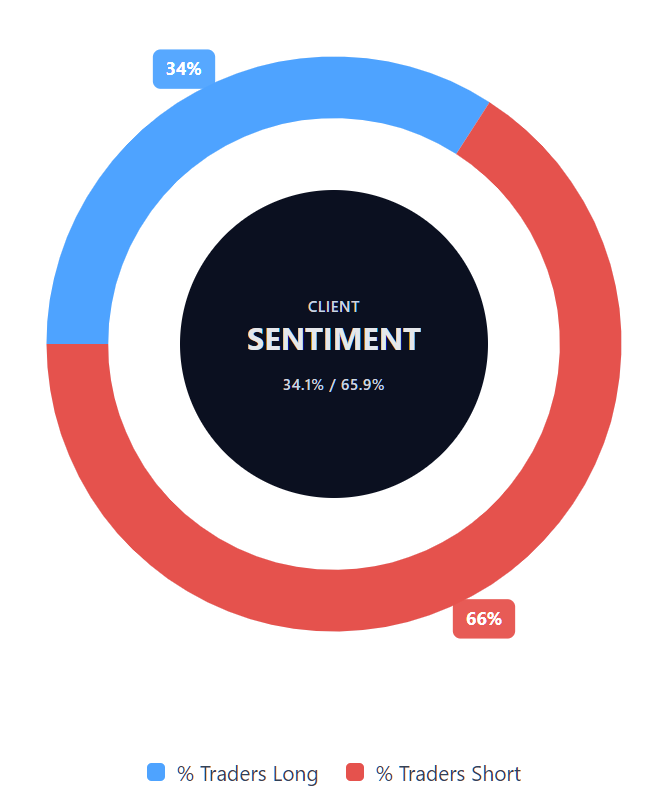USD/TRY forecast 2026–2030: Third-party price targets
USD/TRY continues to react to shifts in Turkey’s economic outlook and wider global conditions, offering a clear view of how domestic and international factors interact across the currency market. Past performance is not a reliable indicator of future results.
As of 8 December 2025, USD/TRY CFDs on Capital.com currently trade near the upper end of its intraday range between 42.3191 and 42.5652 as of 3:17pm UTC on 8 December 2025. The pair remains close to recently recorded all-time highs for December 2025.
The backdrop reflects a broadly firm US dollar, with the Dollar Index trading near 99 after modest gains over the past month (Trading Economics, 8 December 2025). In Turkey, inflation remains elevated but has eased into the low-30% area on an annual basis in late 2025 (Trading Economics, 8 December 2025).
Past performance is not a reliable indicator of future results.
USD/TRY forecast 2026–2030: Analyst price target view
Third-party USD TRY forecasts for late 2025 focus on Turkey’s macroeconomic conditions rather than specific price targets. Nevertheless, these views help frame how analysts assess lira-related risks and, by extension, the currency pair’s direction. Updates between October and December 2025 from major multilaterals highlight shifts in expectations for growth, inflation and monetary policy – key variables for any longer-term assessment of the lira.
International Monetary Fund (Article IV staff view)
In its 2025 Article IV concluding statement for Türkiye, the IMF projects inflation to remain in double digits over the medium term and notes that exchange-rate policy should prioritise smoothing excessive volatility rather than targeting a specific level. The Fund also highlights ongoing dollarisation and FX liquidity risks. Tight monetary policy and greater exchange-rate flexibility are viewed as important for re-anchoring inflation expectations and reducing the need for FX intervention during periods of changing risk appetite (International Monetary Fund, 21 November 2025).
The IMF’s October 2025 World Economic Outlook signals an upward revision to Türkiye’s growth forecasts, projecting GDP to stabilise near the mid-3% range through 2025–2026. Inflation is expected to remain in the mid-30% range in 2025 before easing. The commentary highlights resilient domestic demand and policy adjustments, while elevated inflation and global financial conditions remain key risks for Turkish asset pricing, including the exchange rate (Daily Sabah, 14 October 2025).
OECD (country outlook)
The OECD’s June 2025 Economic Outlook projects GDP growth of about 2.9% in 2025 and 3.3% in 2026, alongside a gradual decline in inflation that nevertheless remains elevated. The report cites tighter financial conditions, fiscal consolidation and softer global trade as constraints on demand, while noting that inflation risks and policy uncertainty could continue to influence sentiment toward emerging-market currencies such as the lira (OECD, 3 June 2025).
A September 2025 OECD summary raises Türkiye’s 2025 growth projection to about 3.2%, up from 2.9%. Even so, inflation is still expected to exceed central-bank targets. The update notes that resilient domestic demand and one-off factors support growth, while high inflation and policy uncertainty maintain focus on reforms and on the lira’s real appreciation against trading-partner currencies (Türkiye Today, 23 September 2025).
Long Forecast (quantitative service)
Long Forecast publishes mechanical projections that place USD/TRY around 43.17 by year-end 2025 and near 52 by December 2026, implying a continued weakening of the lira over the medium term. Its methodology emphasises trend‑following and historical price patterns, rather than discretionary macro analysis (Long Forecast, 8 December 2025).
Predictions and third-party forecasts are inherently uncertain, as they cannot fully account for unexpected market developments. Past performance is not a reliable indicator of future results.
Turkish lira outlook: Technical analysis
As of 8 December 2025, USD/TRY remains above its short- and medium-term trend band, with the 20-, 50-, 100- and 200-day SMAs clustered around 42.4, 42.1, 41.5 and 40.1 respectively. Spot trades near 42.55 as of 3:17pm UTC on 8 December 2025, maintaining a 20-over-50 moving-average alignment. The 14-day RSI of about 75 sits in stretched territory, while an ADX reading near 31.6 points to a trending rather than range-bound environment.
Classic pivot resistance sits at R1 around 42.65, followed by R2 near 42.86 if price closes sustainably above the first level. On the downside, the 42.32 pivot acts as initial support, with the 100-day SMA at roughly 41.5 offering a further reference point. S1 near 42.10 is another level to watch if support gives way on a closing basis (TradingView, 8 December 2025).
This technical analysis is provided for informational purposes only and does not constitute financial advice or a recommendation to buy or sell any instrument.
USD/TRY history
USD/TRY has risen steadily over the past two years, reflecting prolonged lira weakness against the US dollar. The pair closed near 29.12 on 10 December 2023, moved above 30.00 in early 2024 and finished that year around 35.51 – a rise of roughly 22%.
The upward trend continued in 2025. USD/TRY advanced beyond 36.00 in February, crossed 40.00 by late June and reached the low-42s by early autumn. As of 8 December 2025, the pair trades around 42.56, placing it roughly 20% higher year to date and about 46% above its level two years earlier, based on closing prices.
Past performance is not a reliable indicator of future results.
Capital.com analyst view
USD/TRY has delivered sizeable gains over the past two years, moving from the high-20s in late 2023 to the mid-30s by end-2024, and into the low-40s–42 area during 2025 on Capital.com’s feed. While the broader direction has been upward, the trend has included periods of consolidation and temporary pullbacks, meaning momentum has not been uniform throughout.
Macro conditions in both Turkey and the US continue to shape trading behaviour. In Turkey, high domestic inflation and tight policy settings remain significant themes. In the US, the dollar index has softened over the past year, and discussion around interest-rate expectations has been influential. Further progress on disinflation and credible policy actions in Turkey could, in principle, offer some support to the lira, whereas renewed price pressures, political uncertainty or shifts in global risk appetite could have the opposite effect. These are not predictions but examples of factors commonly monitored by market participants.
Capital.com’s client sentiment for USD/TRY CFDs
As of 8 December 2025, client sentiment for USD/TRY CFDs on Capital.com currently shows 34.1% buyers and 65.9% sellers – a majority-sell skew of about 31.9 percentage points. This snapshot reflects open CFD positions on the platform and can change as traders adjust their exposure.

Summary – USD/TRY 2025
- USD/TRY has trended higher through 2025 on Capital.com’s feed, moving from the mid-30s in January to above 42 by early December.
- At 3:17pm UTC on 8 December 2025, the pair traded near the top of its intraday range at around 42.55.
- Technical readings show USD/TRY trading above clustered moving averages in the low-42s, with a stretched RSI that suggests a strong – though potentially extended – trend backdrop.
- Turkey’s mix of high but easing inflation, tight monetary settings and developments in US dollar dynamics continues to form an important context for USD/TRY movements.
- Capital.com sentiment data shows a majority-sell positioning, with around two-thirds of open positions held by sellers.
Past performance is not a reliable indicator of future results.
FAQ
What is the Turkish lira forecast?
Most institutional forecasts published in late 2025 don’t provide explicit USD/TRY targets, but they outline the broader conditions analysts monitor when assessing the lira. Commentary from the IMF, OECD and World Bank points to expectations of moderate GDP growth and inflation that, while easing, remains high by global standards. These institutions highlight the importance of tight monetary policy, progress on disinflation and external financial conditions in shaping the Turkish lira outlook in the medium-term. As these factors evolve, they may influence market views on the Turkish lira, but none of the institutions cited offers a prediction on where USD/TRY should trade.
Why has USD/TRY been rising or dropping?
USD/TRY reflects a combination of domestic and global influences. Through 2024 and 2025, the pair generally moved higher as Turkey experienced elevated inflation and maintained tight monetary policy, while the US dollar remained broadly firm. Short-term shifts in sentiment toward emerging-market currencies, along with changing expectations for US interest rates and the global economic outlook, also contributed to day-to-day movements. These influences can reinforce or offset one another, meaning the exchange rate may rise or fall at different times without a single, dominant driver.
Could USD/TRY go up or down?
USD/TRY can move in either direction depending on future economic developments and market conditions. Traders often monitor factors such as Turkey’s inflation path, monetary-policy decisions, political developments, global yields and the performance of the US dollar. A period of credible disinflation and stable policy settings may support the lira, while renewed price pressures or shifts in global risk appetite could work the other way. These are examples of potential influences rather than predictions, and they don’t imply that any specific outcome is likely.
How can I trade USD/TRY CFDs on Capital.com?
You can trade USD/TRY CFDs on Capital.com, which allows you to speculate on price movements without owning the underlying currencies. You can go long or short, use flexible position sizing and access in-platform tools such as real-time pricing, charts and analysis. Contracts for difference (CFDs) are traded on margin, and leverage amplifies both your profits and your losses.